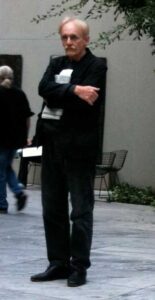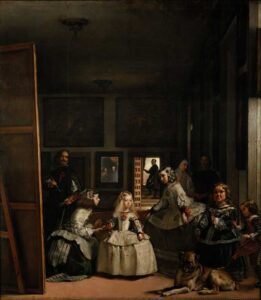
Las Meninas, by Diego Velázquez which Schjeldahl considers the greatest of all paintings. (Wiki commons)
A Review of Peter Schjeldahl Hot, Cold, Heavy, Light, 100 Art Writings 1988-2018
by Victoria Howard in Cornwall

Jarrett Earnest has compiled 100 of the art writings of Peter Schjeldahl, the art critic on The New Yorker. I imagine Earnest and Schjeldahl chose together which pieces would go in the final version. Earnest’s other contribution adds little to the book. His division of the reviews into Hot, Cold, Heavy and Light is downright irritating. He tries to explain his playful, idiosyncratic choices without convincing. The first 10 reviews under the Heavy category are about sculptors, which makes sense. However, the remaining reviews are about painters, a critic (Greenberg), a religious reformer (Luther) and an art dealer (Castelli). How the ‘Heavy’ epithet applies to these I cannot imagine.
I have commented in a previous review on James Elkins’ lamenting that art critics now merely describe art rather than judge it, in my article Elkins on Art Criticism (NAE Volume 34 no 3 January – February 2020 pp 35-36). Peter Schjeldahl is an exception. He describes art beautifully – poetically and eloquently – and he judges it. This however is a relatively easy task as he is commenting on art which is generally not contemporary to him. Sixty four per cent of his reviews about individual artists are of dead artists (three of these are almost like obituaries as they are reviews of exhibitions taking place shortly after death – Basquiat, Haring and Kippenberger). That’s easy isn’t it? History has already pronounced its verdict. Shouldn’t the task of a critic be to evaluate what is new, what is happening now? Far harder to judge what is going to stand the test of time, than to comment on what has already passed the test. Far easier to look back over an artist’s life and see what s/he has contributed to art, than to judge whether a present-day artist is going to sink beneath the waves. He does concede in his review of Lucien Freud that “Retroactively conferring ‘greatness’ on an already high-priced artist transmutes inventories of his work from silver to platinum”. Schjeldahl is referring to commercial value, but in a sense this is what he is also doing with his retrospective reviews. With the pieces on long-dead artists (Rembrandt, Zurbaran, Velazquez, Bronzino, Mantegna, Bellini, Donatello), he is really seizing the opportunity to wax lyrical about his favourite works. And why not indulge yourself after a long life as an esteemed art critic? He claims that Velazquez’s Las Meninas is “the best painting in the world”. The majority of his reviews on actual artists were on dead ones (64%) instead of living artists (36%).
What else can a reviewer of mostly past works bring to the table? Schjeldahl brings quite a lot. Although the reading of it was quite frustrating – I had to read the book with a dictionary in one hand (imbroglio, echt, limned, exegete, mensch, topers, tyro, spondaic, katzenjammer, lucubration, gulled, palimpsestic, velleity, demotic, tatterdemalion – a person dressed in ragged clothing – who knew?). With the other hand I needed to access the internet to look up images of the artworks under discussion which were not familiar to me. However, if the book had been illustrated it would have cost many times more.
There are many redeeming features. Schjeldahl writes beautifully (he is a published poet). James Elkins thinks that art criticism is elevated by intrinsic literary and, at times, poetic value. When asked what they think is important in art criticism, art critics’ top three answers were: description, historical context and writing well (Columbia University’s survey of art critics in Elkins). Schjeldahl nails all three of these criteria.
His descriptions are richly imaginative:
Seeing Van Gogh’s Portrait of Joseph Roulin from 10 feet away, then close up:
‘The near-far contrast, like the blue-green clash, generates aesthetic and psychological heat. Formally, there’s a mighty push-pull. The modelling of the face seems to carve back into shallow space while the background presses forward… But you’d have to be pretty phlegmatic to savor the picture as a formal exercise. When Van Gogh looks at Roulin, what does he see? Pride which he endorses. (Roulin is his friend.) … the dignity … the preening masculinity of the well-tended double cascade of the forked beard. … With the painting’s floral symbolism and its light … Van Gogh associates Roulin with nature. The virile postman is plainly a baby-maker’! (my exclamation mark).
I think Schjeldahl’s prairie upbringing has a lot to answer for. I imagine the uniform landscapes of his youth led to his describing visual art with such richness. He was born in North Dakota in 1942 and grew up in various small towns around Minnesota, the US grain basket. I think the flat plains, the visual landscape of his youth, must have influenced his desire to seek stimulation in art. He dropped out of college at the age of 20 and started as a junior reporter in Minnesota. He then went to Paris for a year and returned to New York in 1965 where he began writing poetry and pieces of art criticism. In 1998 he joined The New Yorker as an art critic. He has won many awards for his art writing and he is proud of the fact that he is not an academic and doesn’t write like an academic. In an interview with Blackbird, the online Journal of Literature and the Arts in 2004, he said that he wants to write things that people want to read. He maintained it was important to have an opinion even if you were wrong; but also that there isn’t a right or wrong when it comes to art and he reserves the right to change his mind. He reckons he takes over where the artist leaves off and then the reader takes over from him.

His wide knowledge of art history is impressive:
‘When Edouard Manet, discovering Velazquez at the Prado in Madrid in 1865, said that he wondered why others, including himself, bothered, he expressed an enduring thought: painting has been done, and Velazquez did it.’
Time and again he places his artists in an historical context.
His eloquent writing digs deep to the heart of things:
‘We can use Velazquez for remembering how to love life: directly, with an attentiveness and a responsiveness that drive thoughts of “love” and “life” out of our heads and consume us like a clear flame. How to make inanimate matter, such as paint, dance attendance – as if the flame painted the pictures – is a secret probably lost forever, but we won’t be wrong in taking it as a compliment. One of us did that.’
Maybe he has a tendency to take liberties with his subjects and ascribe motivations and feelings to them which are invented. He says:
‘Degas’ ballet dancers are not the spun sugar that middlebrow taste supposes. Rather, they are relentless looks at women torturing themselves to be on display. Degas loves to watch them fight balky muscles and gravity, and he doesn’t give a rat’s ass about them otherwise.’
Maybe. Maybe not. But then the astute art critic is like a psychologist, mining the subject’s personality, values, motivations and meanings and coming up with a theory of that person which may carry some truth.
Schjeldahl has plenty to say on the nature of art criticism. He refers to Oscar Wilde’s view that there are many honest painters who object to criticism whose work,
‘… stands in no intellectual relation to their age. It brings us no new element of pleasure. It suggests no fresh departure of thought, or passion, or beauty. It should not be spoken of. It should be left to the oblivion that it deserves.’
Bad artists always admire each other’s work. They call it being large-minded and free from prejudice. But a truly great artist cannot conceive of life being shown, or beauty fashioned, under any conditions other than those he (she) has selected. Creation employs all its critical faculty within its own sphere. It may not use it in the sphere that belongs to others. It is exactly because a man (woman) cannot do a thing that he (she) is the proper judge of it. YES!
He can demolish artists in a phrase: he describes Urs Fischer as a mildly talented Swiss-born sculptor – the international art world’s chief gadfly wit since Maurizio Cattelan faded in the role.
Finally, he has the ability to make you see art, to see it more and see it differently. Bear with me while I give a long quotation from his review of Willem de Kooning:
‘He was an intellectual giant among painters, with an analytical grasp that registers in every move with pencil or brush. A mark by de Kooning always has more than one thing on its mind: direction, contour, composition, velocity. The mark lies on the surface and digs into pictorial space. It makes a shape of itself and describes shapes next to it. Such doubleness derives from Cubism, which gave de Kooning his initial orientation. With crucial guidance from Arshile Gorky, who showed him ways around Picasso’s intimidatingly authoritative permutations, de Kooning blew open the Cubist grid, changing its mode from structural to fluid. De Kooning is to classical Cubism as flying is to walking.’
You see what Schjeldahl is doing here? You don’t have to like de Kooning but Schjeldahl illuminates his contribution to art, which you can do no less than appreciate. There is more:
‘Memories of depiction cling to every stroke. They contribute to a fabulous complexity that, as you look, can supercharge your capacity to maintain disparate thoughts simultaneously.’
Surely we all need more of this ability in our world of prejudice, repression and discrimination.
Discussing Louise Lawler’s photography, Schjeldahl says:
‘There is a recurrent moment, for lovers of art, when we shift from looking at a work to actively seeing it.’
Schjeldahl helps us to do just that.
James Elkins, What Happened to Art Criticism? (Prickly Paradigm Press, Chicago, 2003) Peter Schjeldahl, Hot, Cold, Heavy, Light, 100 Art Writings 1988 – 2018 (Abrams Press, New York, 2019)
Volume 34 no 6 July / August 2020


Please tell me what this paragraph means, especially words I have bolded: ‘We can use Velazquez for remembering how to love life: directly, with an attentiveness and a responsiveness that drive thoughts of “love” and “life” out of our heads and consume us like a clear flame. How to make inanimate matter, such as paint, dance attendance – as if the flame painted the pictures – is a secret probably lost forever, but we won’t be wrong in taking it as a compliment. One of us did that.’
THANK YOU!